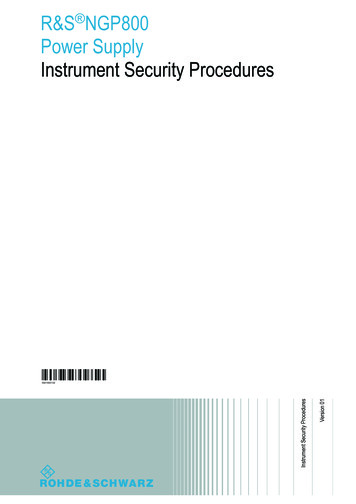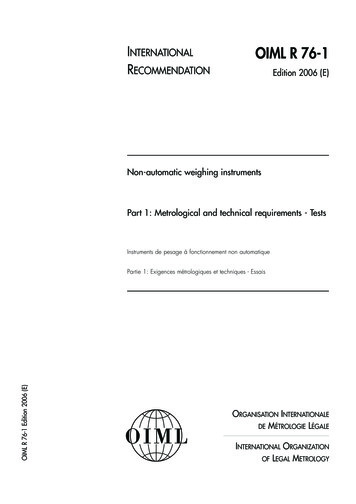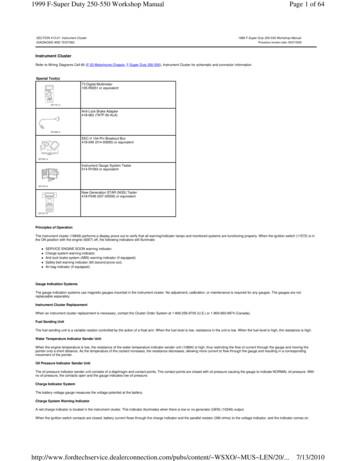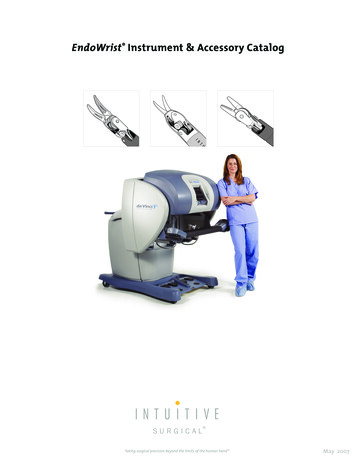
Transcription
R&S NGP800Power SupplyInstrument Security Procedures(Æ1ÊÁ2)Version 01Instrument Security Procedures5601605102
R&S NGP800ContentsContents1 Overview. 22 Instrument Models Covered.23 Security Terms and Definitions. 34 Types of Memory and Information Storage. 34.1Volatile Memory. 44.2Non-Volatile Memory.55 Secure Erase Procedure.56 Instrument Declassification. 61 OverviewIn many cases, it is imperative that the R&S NGP800 Power Supplies are used in asecured environment. Generally these highly secured environments do not allow anytest equipment to leave the area unless it can be proven that no user informationleaves with the test equipment. Security concerns can arise when devices need toleave a secured area, e.g. to be calibrated or serviced. This document describes thetypes of memory and their usage in the R&S NGP800 series. It provides a statementregarding the volatility of all memory types and specifies the steps required to declassify an instrument through memory clearing or sanitization procedures. These sanitization procedures are designed for customers who need to meet the requirements specified by the US Defense Security Service (DSS).2 Instrument Models CoveredTable 2-1: Power Supply modelsProduct nameOrder numberR&S NGP8045601.4007.02R&S NGP8245601.4007.03R&S NGP8145601.4007.04R&S NGP8025601.4007.05R&S NGP8225601.4007.06Instrument Security Procedures 5601.6051.02 012
R&S NGP800Security Terms and Definitions3 Security Terms and DefinitionsClearingThe term "clearing" is defined in Section 8-301a of DoD 5220.22-M, "National IndustrialSecurity Program Operating Manual (NISPOM)". Clearing is the process of eradicatingthe data on media so that the data can no longer be retrieved using the standard interfaces on the instrument. Therefore, clearing is typically used when the instrument is toremain in an environment with an acceptable level of protection.SanitizationThe term "sanitization" is defined in Section 8-301b of DoD 5220.22-M, "NationalIndustrial Security Program Operating Manual (NISPOM)". Sanitization is the processof removing or eradicating stored data so that the data cannot be recovered using anyknown technology. Instrument sanitization is typically required when an instrument ismoved from a secure to a non-secure environment, such as when it is returned for service of calibration.The memory sanitization procedures described in this document are designed for customers who need to meet the requirements specified by the US Defense Security Service (DSS). These requirements are specified in the "Clearing and Sanitization Matrix"in Section 14.1.16 of the ISFO "Manual for the Certification and Accreditation of Classified Systems under the NISPOM".Instrument declassificationThe term "instrument declassification" refers to procedures that must be undertakenbefore an instrument can be removed from a secure environment, for example whenthe instrument is returned for calibration. Declassification procedures include memorysanitization or memory removal, or both. The declassification procedures described inthis document are designed to meet the requirements specified in DoD 5220.22-M,"National Industrial Security Program Operating Manual (NISPOM)", Chapter 8.4 Types of Memory and Information StorageThe R&S NGP800 Power Supplies contain various memory components. The followingtable provides an overview of the memory components that are part of your instrument.For a detailed description regarding type, size, usage and location, refer to the subsequent sections.Instrument Security Procedures 5601.6051.02 013
R&S NGP800Types of Memory and Information StorageVolatile MemoryTable 4-1: Memory typesMemory dureMain Processor InternalCaches andMemory-Startup and operatinginstructions, operatingdata and statesVolatileYesPower OffDDR3 SDRAM2 x 2 GbOperating instructions,user and program dataVolatileYesPower OffeMMC NANDFlash4 GBBoard and device IDs,instrument firmware, calibration data, instrumentsettings, state and userdataNon-volatileYesSecure EraseMCU InternalFlash256 3 KB perchipChannel control firmwareand calibration dataNon-volatileNoNot requiredChannel operating dataVolatileNoPower OffR&S NGP804 x 4R&S NGP824 x 4R&S NGP814 x 4R&S NGP802 x 2R&S NGP822 x 2MCU InternalSRAM32 KB per chipR&S NGP804 x 4R&S NGP824 x 4R&S NGP814 x 4R&S NGP802 x 2R&S NGP822 x 24.1 Volatile MemoryThe volatile memory in the instrument loses its contents as soon as power is removedfrom the instrument. The volatile memory is not a security concern. Removing powerfrom this memory meets the memory sanitization requirements specified in the "Clearing and Sanitization Matrix" in Section 5.2.5.5.5 of the ISFO Process Manual for theCertification and Accreditation of Classified Systems under the NISPOM.Main Processor Internal Caches and MemoryThe R&S NGP800 series have internal caches and memory in its main processor onthe front controller board. These contain startup and operating instructions, operatingdata and states that are critical to device performance and operation. Turning off instrument power will remove user data in the main processor.Sanitization procedure: Turn off instrument powerInstrument Security Procedures 5601.6051.02 014
R&S NGP800Secure Erase ProcedureSDRAMThe R&S NGP800 series has two DDR3 SDRAM memory devices with 2 Gbit each.They contain instructions and data for the operating system and device applications,including measurement and display data, when the power supply is running.SDRAM loses its memory as soon as power is removed.Sanitization procedure: Turn off instrument powerSRAMThe R&S NGP800 series has up to four 32 KByte SRAM devices which are integratedin the power supply’s channel microcontrollers. The SRAMs contain the control andstatus/operating data of the channel control firmware and loses its memory as soon aspower is removed.Sanitization procedure: Turn off instrument power4.2 Non-Volatile MemoryThe R&S NGP800 series contain various non-volatile memories. User data can beremoved from these memories with the Secure Erase procedure.eMMC FlashThe R&S NGP800 series has one 4 GByte flash memory on the front controller boardthat contains board and device IDs, the instrument firmware and the factory calibrationdata. In addition, this flash memory stores all the instrument settings, the instrumentstate, and user data. The flash can hold user data and is non-volatile. Hence, user datais not erased when power is removed from the instrument. The R&S NGP800 seriesprovides a sanitizing procedure that ensures that user data is irretrievably removedfrom the instrument.Sanitization procedure: Secure Erase procedureChannel MCU FlashThe R&S NGP800 series has up to four microcontrollers each with an integrated 256KByte flash memory with 3 KByte Boot Flash. The flash memory contains the channelcontrol firmware as well as calibration data. It does not hold user data nor can the useraccess the storage.Sanitization procedure: None required (no user data)5 Secure Erase ProcedureTo sanitize the internal flash memory, perform the following steps:Instrument Security Procedures 5601.6051.02 015
R&S NGP800Instrument Declassification1. Press the menu button to the left of the R&S NGP800 series' LCD Panel.2. Under the "Device" tab, scroll down to select "Save/Recall Device Settings".3. Select "Factory Reset". Tap "Yes" to proceed when prompted to reset all settings tofactory defaults.4. Tap "Yes" to proceed when prompted to delete all files in "/int".5. Wait for device to reboot and all user data will be removed and factory default settings restored.Do not turn off the instrument during the Secure Erase process!The Secure Erase procedure meets the memory sanitization requirements specified inthe "Clearing and Sanitization Matrix" in Section 14.1.16 of the ISFO Process Manualfor the Certification and Accreditation of Classified Systems under the NISPOM.6 Instrument DeclassificationBefore you can remove the Power Supply from a secured area (for example to performservice or calibration), all classified user data needs to be removed. You can declassifythe Power Supply as follows:1. Sanitize the non-volatile memory as described in Chapter 5, "Secure Erase Procedure", on page 5.2. Turn off the Power Supply. This will sanitize the volatile memory.Following these steps removes all user data from the Power Supply. The Power Supplycan now leave the secured area. These declassification procedures meet the needs ofcustomers working in secured areas.Validity of instrument calibration after declassificationThe permanent adjustment values required to maintain the validity of the R&S NGP800series' calibration are not affected by the Secure Erase procedure. Therefore, performing the declassification procedure does not affect the validity of the instrument’s calibration.Instrument Security Procedures 5601.6051.02 016
R&S NGP800Instrument Declassification 2020 Rohde & Schwarz GmbH & Co. KGMühldorfstr. 15, 81671 München, GermanyPhone: 49 89 41 29 - 0Fax: 49 89 41 29 12 164Email: info@rohde-schwarz.comInternet: www.rohde-schwarz.comSubject to change – Data without tolerance limits is not binding.R&S is a registered trademark of Rohde & Schwarz GmbH & Co. KG.Trade names are trademarks of the owners.Throughout this manual, products from Rohde & Schwarz are indicated without the symbol , e.g. R&S NGxis indicated as R&S NGx.Instrument Security Procedures 5601.6051.02 017
The term "sanitization" is defined in Section 8-301b of DoD 5220.22-M, "National Industrial Security Program Operating Manual (NISPOM)". Sanitization is the process of removing or eradicating stored data so that the data cannot be recovered using any known technology. Instrument sanitization is typically required when an instrument is










